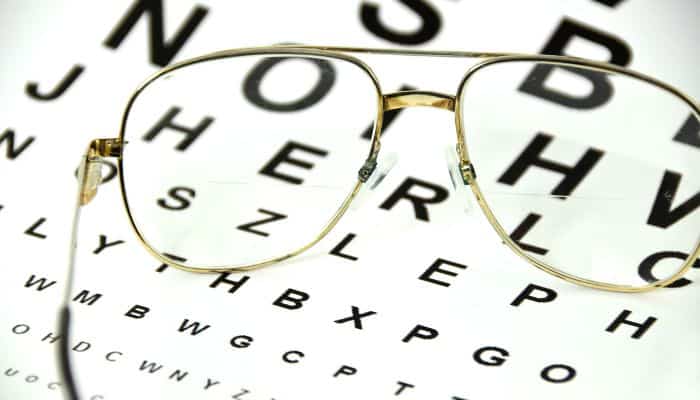If you wear glasses, you’ve likely heard of single-vision, bifocal and progressive lenses. But do you know which lens types are the best for your needs? In this post, we’ll compare single vision vs. bifocal vs. progressive lenses to help you decide which one is right for you.
We’ll discuss the differences between the lens types, the benefits and drawbacks of each one and which type of eyeglass wearer should consider which lens.
Ultimately, you will have all the information necessary to make an informed choice about your next pair of eyeglasses. So keep reading to learn more!
(This page contains affiliate links. OGR may receive compensation if you click a link and make a purchase.)
Single Vision Lenses

Single-vision lenses are designed to correct one field of vision. These lenses can be used for either distance or near vision, depending on the prescription.
Single vision – or monofocal (“one vision”) – lenses are great for individuals with simple corrective needs, such as those with nearsightedness or farsightedness.
They can also be used to correct astigmatism, although this may require a special lens design for optimal vision correction.
Use Cases For Single Vision Lenses
The vast majority of over-the-counter reading glasses, as well as prescription glasses, are single vision lenses. Here are the vision issues that single vision lenses are ideal for:
Nearsightedness (Myopia)

Myopia – or nearsightedness – is a common refraction error that causes far away things to look blurry.
It is caused by the cornea being too curved or the eyeball being too long, making it difficult to see distant objects clearly.
Farsightedness (Hyperopia)
Hyperopia – or farsightedness – is caused by either an overly flat cornea or an eyeball that is too short.
This can cause objects at a distance to be seen clearly, but close up objects to appear blurry.
Aging Eyes (Presbyopia)

Presbyopia is a common condition that affects most people as they get older. It’s caused by the lenses in our eyes becoming stiffer and less able to focus on nearby objects, making it difficult to read or do detailed work up close.
Single vision lenses can be used to correct this condition.
Astigmatism
Astigmatism is a more complicated vision issue and may require cylindrical or spherocylindrical lenses for optimal correction.
Many people have a combination of single-vision errors (nearsightedness or farsightedness) along with astigmatism, which can be corrected with single-vision glasses.
Benefits of Single Vision Lenses
Single vision lenses are the most affordable and straightforward type of corrective lens available.
They also provide the most unobstructed surface area for a wide field of vision, since the prescriptive correction covers the entire lens surface.
They are easy to use, easy to adapt to, and can correct a variety of vision issues.
Drawbacks of Single Vision Lenses
The main drawback with single vision lenses is that they are designed to correct only one field of vision at a time.
This can make it difficult for those who need correction for both near and far vision, as the same lens cannot be used for both.
Bifocal Lenses

Bifocal lenses are very similar to single-vision lenses, but with one important difference: they are designed to correct two fields of vision (“bi” meaning two, vs. “mono” meaning one).
The top portion of the lens is used for distance vision, while the bottom portion is a second lens with corrective power for near vision.
This means that you can see both distance and near objects clearly in one pair of glasses.
Use Cases For Bifocal Lenses
Bifocal lenses are ideal for individuals with presbyopia or anyone having difficulty focusing on near objects.
Benefits of Bifocal Lenses
The primary benefit of wearing bifocal lenses is that it allows you to see clearly at different distances.
This means you’ll be able to read a book or watch a movie with the same pair of glasses.
Depending on your age and degree of vision impairment, bifocal lenses may also reduce eye strain caused by trying to focus on things up close or far away for too long.

They also come in a variety of designs, such as flat-top or round-segmented bifocals.
Drawbacks of Bifocal Lenses
The main issue with bifocal lenses is that they can be difficult to adjust to.
The two fields of vision are clearly delineated in the lens, which can create a jarring jump when your eyes move from one to the other.
Additionally, bifocals are often a dead giveaway that you are officially middle-aged or older, which can be a source of embarrassment for some.
Bifocals vs. Trifocals

Trifocal lenses are like bifocal lenses, but with a third lens devoted to correcting near vision at an intermediate distance.
They are essentially an upgraded version of bifocals designed to correct three fields of vision (“tri” meaning three).
While bifocals work great for those switching from reading distance to viewing things far in the distance, some people need more clarity when viewing things that are neither very close up nor totally far off.
Intermediate vision – approximately 18-24 inches away from you – such as viewing a computer monitor, is where trifocals can serve someone better than bifocals.
Progressive Lenses

Finally, progressive lenses are also multifocal lenses designed to correct near, intermediate and far vision – but in a single continuous lens.
Progressive lenses gradually transition from one field of vision to another, without any visible lines or jumps between them.
Use Cases For Progressive Lenses
Progressive lenses are ideal for individuals with presbyopia or anyone who has trouble focusing with near and far vision.
They are also great for those who need bifocal correction but don’t like having a visible line between the two fields of vision.
Benefits of Progressive Lenses
The main benefit of progressive lenses is that they provide a seamless transition between near, intermediate, and far vision.
This makes them more comfortable and natural-looking to use than bifocals or trifocals, as there are no visible lines or jumps between different fields of vision.
They’re also much more customizable than standard bifocals or trifocals, allowing for the exact prescription that you need.

Drawbacks of Progressive Lenses
The main issue with progressive lenses is that they can be difficult to adjust to.
The gradual transition from one field of vision to another can be disorienting at first.
You have to learn to look through the appropriate part of the lens for each field of vision. There are also blurry areas in between that can make it difficult to focus, particularly in your peripheral vision.
Lastly, progressive lenses are more expensive than single-vision or bifocal lenses, as they require more sophisticated manufacturing processes.
In Conclusion
Now you know: single-vision lenses are the most common and affordable option. They’re perfect for most vision correction needs in the vast majority of people.
Bifocals are great for those who need help seeing both near and far without breaking the bank.
Finally, progressive lenses offer the most natural multifocal vision correction around. Their seamless design and gradual transition between focus zones make them optimal for who need more precision than standard bifocal lenses can provide.